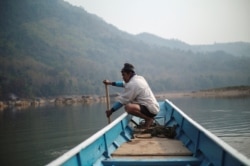The ambassadors of Thailand, Vietnam and Cambodia have called for greater support from the U.S. and the ASEAN regional bloc to address urgent environmental threats to the Mekong River. They also emphasized the need for improved water data sharing by all countries on the river, including China.
Vietnamese Ambassador to the U.S. Ha Kim Ngoc told a virtual panel hosted by the East-West Center in late February that U.S. support to address challenges to the Mekong River should be expanded while adding that Hanoi also wanted ASEAN engagement to help meet the challenges.
“We strongly believe US leadership and commitment will be a very decisive factor for the success of our collaboration to help the Mekong," he said.
“ASEAN needs to put a higher priority on this issue. In our region, we have some top priority issues, including the South China Sea, or what we call the East Sea. For Vietnam and some other countries in the region, the Mekong is also of strategic significance in terms of security, prosperity, and stability of the whole subregion.”
Water data sharing and transboundary governance
Ha Kim Ngoc said some 20 million Vietnamese depended directly on the Mekong Delta. Since 2015, two historic droughts have caused some $1 billion in damages.
“This will happen more often if we fail to act quickly especially in strengthening of the governance of transboundary water resources,” he said, adding that Vietnam wanted all countries along the river to share water data, manage resources responsibly, and set ‘rules and norms’ for water use management by all countries.
Vietnam, Thailand, Cambodia and Laos are part of the Mekong River Commission (MRC), which is based on a 1995 agreement that fosters cooperation, but does not legally bind countries to unanimously agree on their water use. China, which is home to the Upper Mekong, and Myanmar, which is also on the river, are not MRC members.
The panel, which also included a top U.S. State Department representative for Asia and House of Representatives Foreign Affairs Committee member Rep. Ted Lieu (D-CA), discussed a new report by the Congress-funded East-West Center. The report emphasizes the need for transboundary management of the Mekong to address pressing challenges posed by climate change, shifting hydrological conditions, chronic droughts, and natural disasters.
In recent years, extreme droughts have hurt the Mekong’s extraordinary natural productivity, which is important to tens of millions of people who survive on fishing and agriculture.
Thai Ambassador Manasvi Srisodapol said, “There are a lot of development needs along the Mekong River. We feel that ASEAN, having limited capacity, cannot develop the Mekong by itself. We need partners. We have plenty of partners that are interested in helping our development needs, either bilaterally or in subregional frameworks, including the [U.S.-led] Lower Mekong initiative and other U.S. partnerships.”
“Strengthening the river’s governance and transparency is central” to addressing the Mekong’s challenges, he said, adding that, “Thailand supports sharing of timely accurate and high-quality water data on the mainstream Mekong River.”
Cambodian Ambassador Chum Sounry welcomed U.S. support for the region, but stopped short of calling for transboundary governance. He cited a recent MRC Secretariat statement that called on, “China and the Lower Mekong countries themselves to share water data with the MRC to help Lower Mekong countries to manage risks more effectively.”
Concern over China, Laos dams
In the past year, the MRC Secretariat, Vietnam and Thailand have voiced strong concerns over the impacts of large hydropower dams upstream in China and Laos on the river’s flood pulse downstream.
Laos has shrugged off these concerns, while China has denied that its dams impact downstream water levels. Beijing only recently, after continued complaints, agreed to share water level data from its dams with the MRC, though questions remain.
The U.S. has strongly echoed the concerns that China’s lack of cooperation and transparency over its use of the Mekong is having negative impacts downstream, and the issue appears to have become part of the U.S.-China rivalry in Southeast Asia.
In the panel, Rep. Ted Lieu and Atul Keshpa, U.S. Deputy Assistant Secretary of State for the Bureau of East Asia and the Pacific, reiterated this position.
“We remain concerned… that (Mekong) record droughts and the upstream dams in China that exacerbate them, are hurting the communities and ecosystems that have relied for countless generations on the Mekong River’s flood pulse,” Keshap said.
He questioned whether China was sharing its water data with the MRC in a timely and effective manner, saying, “It is clear… these commitments are not being met.”
Since 2009, the U.S. government has worked on cooperation programs with the Mekong countries. It recently launched a new $150-million program to address environmental challenges to the river basin and to support energy markets and combat transnational crime.
In December, the U.S. State Department also support the launch of the Mekong Dam Monitor, which uses cloud-piercing satellites to track water levels at 11 upstream dams in China and other Mekong countries. The Stimson Center think-tank, which operates the Mekong Dam Monitor, said the data shows that China’s operation of the dams maximizes its interest and fails to consider downstream impacts.










